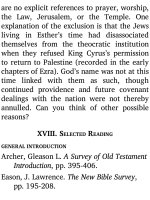Jensens survey of the old testament adam 458
Bạn đang xem bản rút gọn của tài liệu. Xem và tải ngay bản đầy đủ của tài liệu tại đây (172.31 KB, 4 trang )
12The Corinthian Letters
1 Corinthians: Problems of a Local Church
2 Corinthians: Paul’s Apostolic Ministry
The Corinthian letters immediately follow
Romans in the New Testament canon,
though in point of time they were written
just before Romans (see Chart 1, p. 20).
Their location in the canon shows a topical
progression when one considers general
emphases.1 Observe how this is shown in the
accompanying diagram.
THE GOSPEL OF JESUS CHRIST
The Corinthian letters apply the Roman
letter’s interpretations of the historical books’
facts. Seen from another view, the church,
which is the subject of the Corinthian
letters, is the outcome of salvation, which is
the subject of Romans.
I. PREPARATION FOR STUDY
A. PAUL’S JOURNEYS
Review Paul’s missionary journeys and his
ministry of writing New Testament letters
(Chapter 7). This will help you see clearly
just where the Corinthian letters t in the
chronological sequence of his writings. It
will help to adjust your perspective, having
just studied Romans.
B. THE LOCAL CHURCH
The
Corinthian
letters,
especially
1
Corinthians, focus on the operations of the
local church. Observe in an exhaustive
concordance how often the word church(es)
appears in the letters. Re ect on the
importance of this vital organism of God’s
working. New Testament references to
church are of three different kinds:
1. Invisible church — all believers,
whether alive or dead, who are
members of Christ’s Body. (Read
Ephesians 1:22-23; 5:23, 25-27.)
2. Visible church at large — a constituency
of all believers living at any one time
(Acts 8:3; cf. “churches” in Acts 9:31).
3. Visible local church — a fellowship of
believers who worship in a given
locality (e.g., Corinth, 1 Cor. 1:2). It is
possible for persons to have their
names on the membership roll of a
church, and not be believers (cf. Rev.
2-3).
A local church, such as the church of
Corinth, is a geographically con ned
fellowship of believers, a visible outworking
of the invisible church. It is important to
have clearly in mind just what the invisible
church is and whom it comprises. Read 1
Corinthians 10:32, and note the reference to
three groups: Jews, Gentiles, and the church
of God.2 Chart 69 identi es these in the
stream of the human race.3 Refer to this
chart in the discussion that follows.
In the early generations of the human race
there were no group distinctions, such as
Jew and Gentile. All the descendants of
Adam were as one family, “children of
men,” and God spoke to the whole race,
seeking to get all people to obey Him and
fellowship with Him. The race as a whole
refused to do this, although there were some









